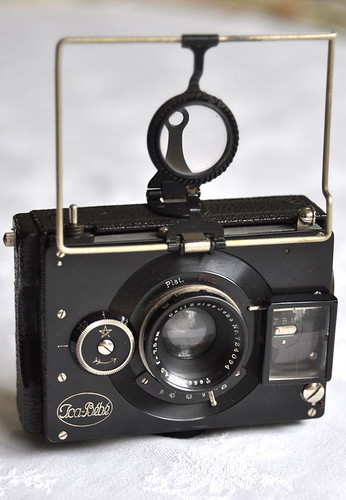Ica Bébé

|
| 4.5x6cm Bébé image by Jacques Lepine (Image rights) |
Early model
The Bebe (or Bébé; the name appears accented on the camera itself, as pictured here, but is written without the accents in both the English and German catalogues[1][2]) is a small plate camera introduced to the market by the small swiss camera maker Zulauf in 1906, other sources say 1908. Production resumed at ICA in Dresden in 1911, after Zulauf merged with ICA. The early model takes 4,5 x 6cm glass plates. Zulauf cameras carry a G.Z.C. logo in an oval and separate Bebe lettering. Later ICA cameras have ICA-Bebe written in the oval. The shutter is a modified Compound (up to 1/250s) and known lenses are either Zeiss Tessar 7.5 f/4.5 or Zeiss Triotar 7.5 cm f/3.5. The camera allows some lens board movements.
Later model, about 1925
ICA catalogues of about 1925 show another model of the camera, and describe it as new.[1][2] It is a strut-folding camera, now made in two sizes. Each has a dial-set Compur shutter with speeds from 1s to 1/250 second.
- Model A (listed as model 40/2 in the German catalogue) is for 4.5x6cm (1¾ x 23/8 inch) plates, or film-packs. with Tessar 3-inch f4.5 lens
- Model B (listed as model 41/2 in the German catalogue) is for 6.5x9cm (2½ x 3½ inch) plates.
The US catalogue lists the cameras only with f/4.5 Tessar lenses, 3- and 4-inch respectively; the German one lists the smaller camera with a choice of f/4.5 Tessar or f/3.5 Triotar. Both catalogues make a point of stating that focusing is not by a helical mount but by rotating the front element: as the picture here shows, this required two different focus markers, because of the different planes of focus for plate-holders and the film-pack adapter. The German catalogue states that the larger camera has front rise. The cameras have both an 'Ikonometer' folding frame-finder, incorporating a close-up lens, and a smaller Newton finder.
Links
- Ica Bébé early model at Early Photography
- Ica Bébé Model A at Historic Camera
- Ica Bébé Model B at Historic Camera
Notes
- ↑ 1.0 1.1 ICA Cameras English-language catalogue, 1925 (the upper link), page 39, at Mike Butkus' Orphan Cameras.
- ↑ 2.0 2.1 ICA Cameras German-language catalogue, 1925, page 3, at Camera Eccentric.